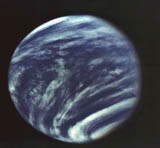




 |
||
|
Venus is the hottest planet in the Solar System. It is too hostile today to harbor life as we know it. The runaway greenhouse effect, caused by its dense atmosphere, drives surface temperatures to uninhabitable levels. If life did exist it did so long ago, when conditions were more Earth-like. The USA and the Soviet Union began studying Venus in the early 1960's with NASA's Mariner II Mission and the early Venera series of spacecraft. Pioneer Venus, various Soviet Venera missions and the Magellan mission also provided information about the surface of the planet in the years that followed. Although controversial, data suggest that ancient lakes may have once existed on Venus. The planet may have had a large volume of water in its atmosphere and on its surface, in the distant past when the climate was cooler. If large bodies of water did exist, they could have lasted for several hundred million years until they boiled away as temperatures rose. Icy comets , or volcanoes, could have resupplied the oceans for a billion years or so. Electrical activity in the atmosphere and volcanic activity in the mantle would have been important energy sources for the production of organic chemical compounds, similar to those that can be produced by the Miller-Urey experiment. But this is a long way from the creation of life and any speculation about life developing independently on Venus must remain just that. For even if we can one day find a means of exploring the planet, virtually all traces of the existence of life will have been obliterated by the heat and active chemistry. Something to note however is that Venus, like the Moon and Mars, will have been a recipient of Earth rocks through impact ejection. So once again life could have been transported to Venus, as it certainly may have been to the rest of the Solar System. It could have found a suitable home to thrive, but as Venus become hotter under its blanket of runaway green-house gasses, life would have become intolerable even for the most robust archaean thermophile. © All images NASA, unless shown |
Go
to
Home
| Space Station
| Mars | Rainforest
© 1999 Satellite Events Enterprises Inc.